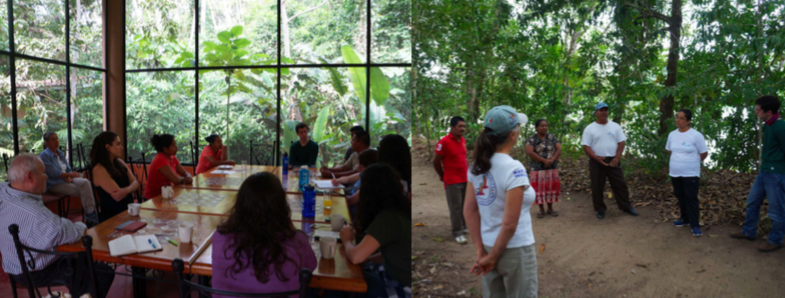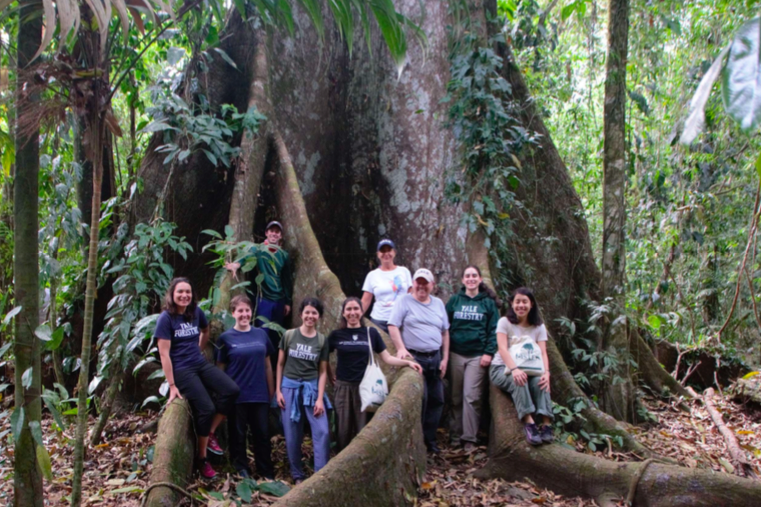Student Grant Reports - Conference Study Tour
Renata Lozano, Fabiola Hernandez, Sandra Chiri, Alberto Tordesillas, Maria Urrutia, Josefina Cobian, Melaina Dyck
Chiapas, Mexico
Background
In Spring of 2018, as organizers of the annual F&ES Sustainable Development in Latin America and the Caribbean (SDLAC) conference, we invited Dr. Julia Carabias as our conference closing keynote speaker. Dr. Carabias is the former Minister of the Environment for Mexico, a professor of biology at the National Autonomous University of Mexico, founder of the conservation nonprofit organization Natura Mexicana, and recipient of the Belisario Dominguez Medal, the highest honor awarded to Mexican citizens. The theme of the 2018 SDLAC conference was “The Silent Leadership” and we felt that Dr. Carabias, a strong woman leader and advocate for marginalized communities, exemplified the values of this conference. Dr. Carabias’ keynote address highlighted Natura Mexicana’s success in working with communities living in La Selva Lacandona, Chiapas, Mexico, to develop ecotourism projects as alternative livelihood strategies to support forest conservation.
Following her keynote address at the conference, Dr. Carabias invited F&ES students to visit Natura Mexicana’s ecotourism projects on a field trip that would provide concrete examples and share lessons-learned for community-based conservation efforts for the students as well as economically support the community-owned and operated ecotourism businesses. Through close collaboration with Dr. Carabias over the subsequent eleven months, we developed a 5-day conference study tour to take place March 18-22, 2019 in and around the Montes Azules Biosphere Reserve in the Lacandona Jungle in southern Mexico. Seven students from the Yale School of the Environment were able to participate thanks to support from the Yale Council on Latin American and Iberian Studies (CLAIS), the Yale Center for the Study of Race, Indigeneity, and Transnational Migration, and F&ES.
The Lacandona Jungle is located in southeast Mexico, near the border with Guatemala. It is one of the most biodiverse areas in Mexico. The region is a major source of freshwater for the country. Two river basins in Lacandona, the Usumacinta and the Grijalva, carry around 30% of the Mexico’s freshwater. Although the jungle occupies only the 0.16% of the surface of the country, it contains around 50% of the bird species and other rare species including tapir, red parrot, scarlet macaw, spider monkey, howling monkey, jaguar, wild pig, and ocelot.
This biodiverse region is threatened by deforestation, especially in the buffer area around the Montes Azules Biosphere Reserve. This buffer area is essential habitat for many wildlife species that live and move though this corridors. The drivers of deforestation are multiple and complex, however, one of the main pressures on the Lacandona Jungle is the conversion of land for agriculture and cattle raising.
Forest and wildlife conservation in this area face many challenges. One challenge that can also provide opportunities for conservation is the unique ejido system for land tenure in Mexico. An ejido is a small area of land owned collectively by the residents who were granted the ejido. The ejido system was established following the 1910 Agrarian Reform in Mexico as a means to redistribute land. Today, about 50% of Mexican territory is held under ejidos. This dispersed system of land ownership poses challenges for the Mexican government to implement large-scale land use plans--including plans for conservation. However, the ejido system of collective management can put communities in a good position to engage in community-based conservation. Natura Mexicana is working effectively within the ejido system to collaborate with individual communities to develop a variety of conservation plans.
The institution that hosted us during our trip was Natura Mexicana, a Mexican NGO which is dedicated to the conservation of the Lacandona jungle. Natura Mexicana works both within protected areas like Montes Azules Biosphere Reserve and adjacent buffer zones. Natura Mexicana is engaged in a wide variety of conservation, monitoring and community-outreach projects at its two field stations located along the NAME river, which is the border between the reserve and the buffer zone. Natura Mexicana’s projects include: monitoring of forest conservation and deforestation in the Lacandon forest; research on endangered species and the recovery of key species facing extinction, such as the Scarlet Macaw; extensive tracking of species and changes in the forest through camera trapping; and outreach to local communities to engage residents in monitoring work as well as community-based conservation and ecotourism projects. The success of Natura Mexicana’s ecological conservation and monitoring projects is possible because of their commitment to collaborate with and strengthen the capacities of local residents, and the organization keeps community engagement at the center of all of their project. Natura Mexicana is an incredible model of how to approach conservation through implementing innovative, bottom-up strategies that conserve forest and endangered species while improving the livelihoods of local residents.
Ecotourism and conservation in the Lacandona Jungle
During our visit to the Lacandona jungle, we visited five different ecotourism projects that Natura Mexicana has developed in collaboration with residents of local ejidos. The five projects have different but similar business models, which depend on the services and resources the landowners in each ejido can offer. In each ejido where these projects were built, any landowner who set aside land for conservation had the right to own a share of the ecotourism business. Most employees of the ecotourism businesses are also residents of the ejido where the project is located. However, some projects welcomed motivated workers from neighboring areas.
The five project we visited were:
- Selvaje, located in the ejido “El Piru.” Selvaje offers adventure activities like kayaking down a river, zip lining and canopy walks, as well as bathing in thermal springs.
- Campamento Tamandua, located in the ejido “Flor de Marques.” In this camping site visitors spend the night in luxurious tents that can fit up to 4 people. They offer 6 different hiking tours of varying lengths around the jungle. Each tour has unique attractions, such as exploring a cave and visiting sights along the rivers.
- La Casa del Morpho, located in the ejido “Playon de la Gloria.” With the guidance and help from different conservation organizations, this project has a butterfly garden. Women who are part of the business also have a store with handcrafts created with butterfly wings.
- Bella Vista is one of the newest projects. It is a restaurant with a beautiful vista to a river and jungle. They also rent their facilities for social events including weddings and movie screenings.
- El Canto de la Selva, located in the ejido “Galacia.” They offer comfortable, high- quality accommodation facilities where important Mexican personalities, including presidents and famous filmmakers, have stayed. They also offer hiking tours around the jungle.
During our visit to the five projects, we had the opportunity to talk to community partners about their motivations to engage in ecotourism as well as the benefits they receive from running the projects. In addition to revenue, benefits include having access to training, interacting with visitors from different parts of Mexico and the world, and the opportunity to share their culture and knowledge on their environment with visitors. Something that became evident during our conversations with people in the projects was the active participation of women and young people. For women in particular, the ecotourism projects are bringing new opportunities for them to acquire new technical skills, generate additional income for their homes, and to strengthen their self-confidence. Young generations are also attracted to join the projects, so they feel incentivize to stay in their communities rather than migrating to cities or to the U.S.
.png)

